The DCSki User of the Month program recognizes some of the best members of the DCSki community based on their contributions to the DCSki Forum. Individuals selected for this Program are interviewed and receive an exclusive DCSki pin that they can proudly wear on their ski jacket.
We’re pleased to announce that Denis Bogan has been selected as DCSki’s User of the Month for December 2020. A long-time member of the DCSki community, Denis is known for sharing a lifetime’s worth of ski experiences through over 2,000 thoughtful posts to the DCSki Forum. But many readers may not realize that Denis has also had an illustrious career including stints in the military, teaching chemistry as a college professor, and working as a mission program scientist at NASA. Learn more about Denis in our interview below.
Denis Bogan, also known as “Denis” on the DCSki Forums, is User of the Month for December, 2020.
Scott: Let’s begin with your first memory on the slopes. When were you first introduced to the sport?
Denis: I grew up in a Boston suburb in the 1940s and 50s. One year all the neighborhood kids wanted skis for Christmas. Most put theirs in the garage to gather dust after one or two tries. I was 7 and loved it, the start of a lifelong love affair. Those first skis were toys, replaced as I grew with 6 ft. solid wood skis, no edges, no laminations, and Kandahar cable (bear trap) bindings.
The boots were leather lace ups, similar to hiking boots. We had a long snowy winter that year and 2 friends and I began skiing golf course hills after school. We would climb up using the “herringbone” technique and ski down. It was great fun and a great workout. My parents had modest means and didn’t ski, but approved it as a healthy sport that could last a lifetime. The Depression and World War 2 had stolen their opportunities to be adventurers.
Scott: Do you remember the first ski resort you visited?
Denis: At 16 I took a youth group trip to North Conway, New Hampshire for a weekend of skiing at Cranmore Mountain, one of the cradles of American skiing. Later, a few college buddies and I would drive to New Hampshire for our favorite, Wildcat Mountain. We’d stay in cabins with no heat or water for $0.50/night, just a potbelly stove, bring your own sleeping bag and firewood. I was still using the edgeless skis on icy slopes with no snowmaking and no grooming. You aimed to turn where it didn’t shine, and failing that just took a fall and slid to a stop, hoping not to hit anybody or any trees. Skilled adult skiers quickly learned to stay away from us.
I carried two Snickers bars to eat on the lifts for lunch. We never stopped for lunch. This was about 1960 and we could do a weekend for $20, covering gas, lift tickets, lodging and food. I recall that when Stowe went from $4.50 to $6.00 per day, I thought they had killed the business. Nobody would ever pay that. I was a high school and college cross country runner and set the record on my high school course, so the physical rigors of ski bumming like this never bothered me.
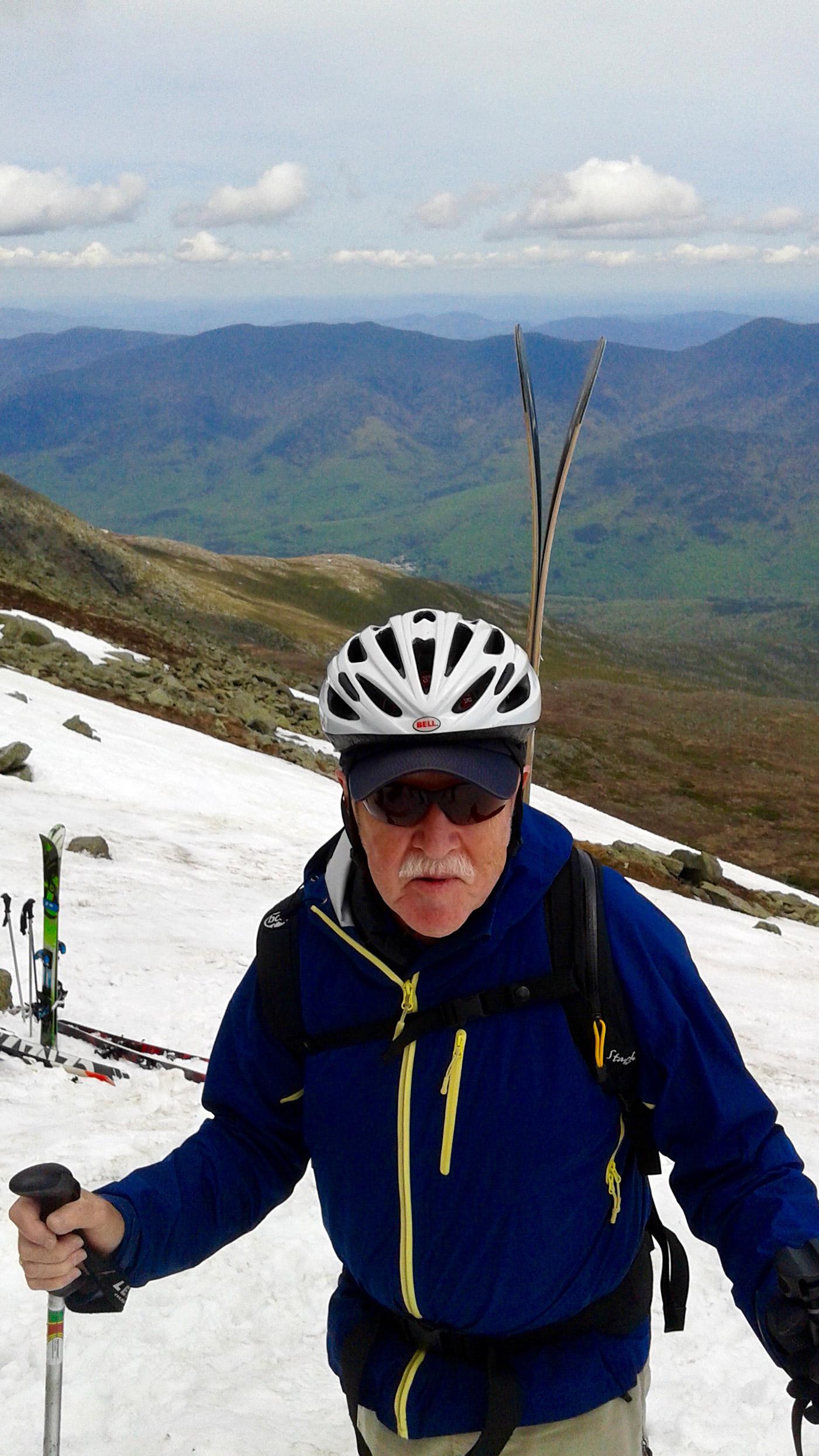
Memorial Day 2017 at New Hampshire’s Mt. Washington. Photo provided by Denis Bogan.
Scott: How did your connection to skiing evolve after you graduated from college?
Denis: A month after graduating from Northeastern University I was at Ft. Gordon, Georgia as a newly commissioned 2nd Lieutenant, U. S. Army. I had been in the ROTC program and had a 2-year obligation. For some unknown reason, I was left there for the full 2 years to watch one friend after another sent to Vietnam. Some didn’t come back.
I began grad school at Carnegie Mellon a month after discharge, married the following year, and had a daughter. We had to pinch pennies but avoided the borderline poverty of many grad students thanks to the GI Bill. Next came a PhD in physical chemistry and two post docs, each of two years duration. Remaining in the field of one’s degree was nearly impossible and still is for PhDs.
I beat the odds and became a permanent staff member at the Naval Research Laboratory in Washington, DC. It was a golden age for basic research in physics and chemistry; we had lasers, mass spectrometers, computers, vacuum systems and all manner of instruments. It was great fun, but also very demanding. I worked 60-80 hours per week for a decade beginning with starting grad school in 1967. You have to keep the publications coming. Publications are the currency of science. It was a decade without skiing.
Scott: But you were eventually able to reconnect with the sport. How did you find your way back to skiing?
Denis: The Naval Research Lab instituted a ski club in the 70s, the Snow Searchers Ski Club, still in existence. Our daughter was 4 and I carefully crafted and rehearsed a sales pitch to my non-skiing wife: basically, “what a great father-daughter bonding activity.” Success! My wife has been supportive of our skiing ever since. We have been married for 51 years now.
Our daughter and son both took to skiing like fish to water. I got them the best equipment and lessons and new stuff for myself. My, how I had missed skiing. One by one we visited all the Mid-Atlantic areas. I took up telemark so as to be able to ski with little kids and still be challenged. It felt like a return to the roots of the sport, which had great appeal so I’ve stayed with it ever since.
We began taking weekend and then once-per-year trips to New England, Killington, Sugarloaf, Stowe, and Mad River. Next came NASTAR racing and a season on the Ski Liberty Race Team. That was really a key step. In racing you turn where you have to, not where you want to. It develops skills rapidly. I didn’t compete, just trained at least 1 night per week and 1 day per weekend. Suddenly I could ski a zipper line of bumps rather than “shopping for a turn” (instructor’s expression).
Scott: About how many total ski areas have you been to now?
Denis: Well over 100. I counted in answer to a challenge about 15 years ago. I don’t know where I put that list, but at least 20 more have been added since.
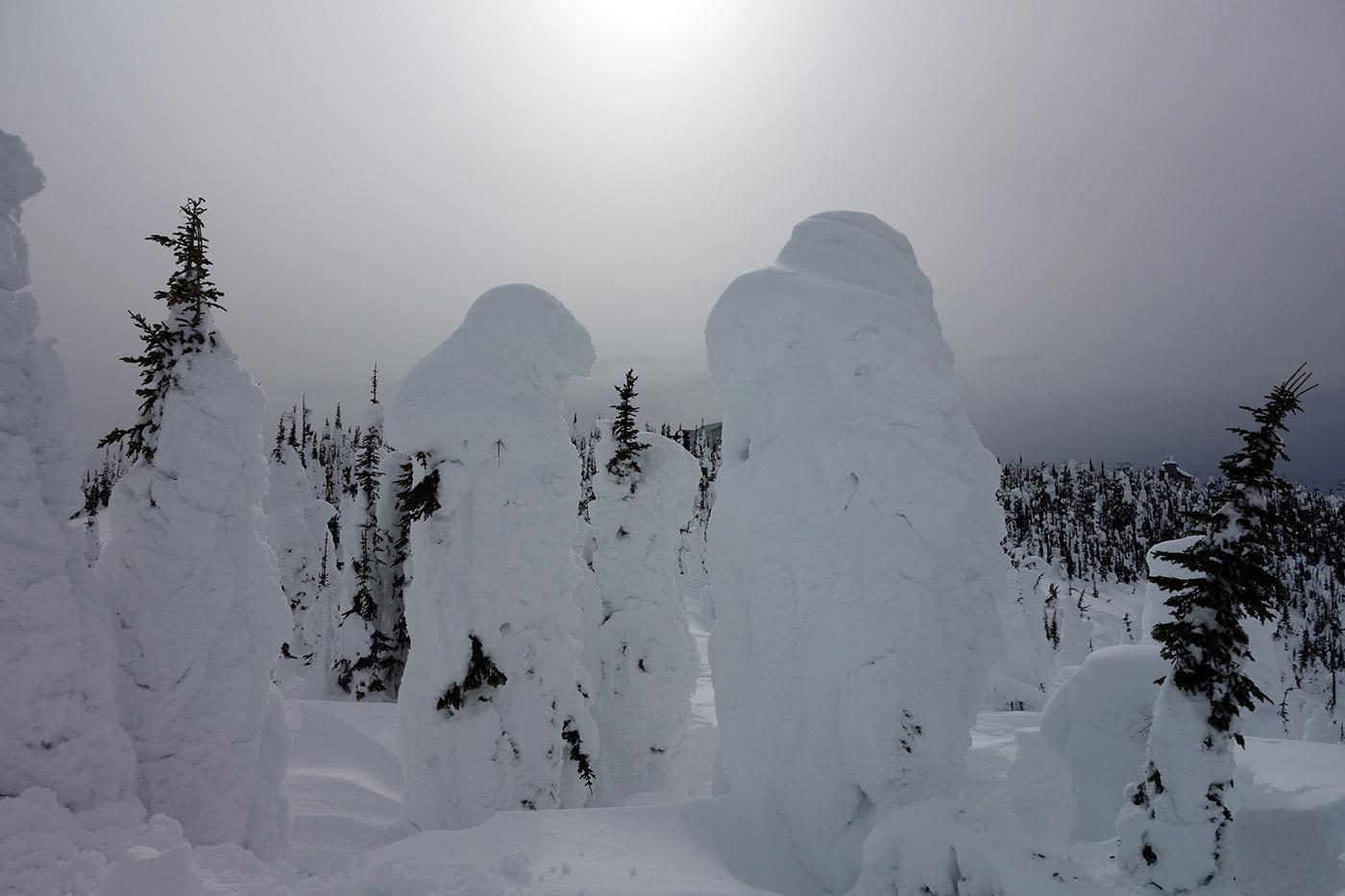
Ghost trees at Montana’s Whitefish. Photo provided by Denis Bogan.
Scott: What is your fondest memory from skiing in the Mid-Atlantic?
Denis: I had many great days at Blue Knob and at Whitegrass. In the later years I relished untracked snow at Whitegrass rather than the groomed slopes of our local ski areas. All skiing is fun but I enjoyed the feeling of oneness with the mountains and the added challenge of skiing what nature gave us.
Scott: Do you recall any seasons in the Mid-A that were particularly great, for example due to record snow or an extended length of season?
Denis: There was a string of seasons in the early 2000s when Timberline was open into the second week of April. If memory serves, four seasons out of say six when we skied powder in April.
Scott: There has been a lot of change in the Mid-Atlantic ski scene over the years. We’ve seen a corporate consolidation of ski areas, such as Vail’s acquisition of numerous Pennsylvania ski areas, and we’ve also seen the rebirth of neglected areas such as Laurel Mountain and Timberline. During your time skiing in the Mid-A, what was the biggest change you witnessed?
Denis: I am a big fan of smaller stand alone areas where I think the spirit of skiing is still to be found. I think that skiing should be affordable to families. The multi resort season passes are a great deal for frequent skiers who are into the sport, but not at all a good deal for bringing in new skiers and young families. The day ticket prices are very high and the number of days to the break-even point on season passes is beyond the reach of occasional skiers. I fear that the mega pass resorts are eating the seed corn.
Scott: What is one thing that is better about skiing in the Mid-A today, and what is one thing that is worse?
Denis: Honestly I did little Mid-Atlantic skiing in the later years of living in Northern Virginia. Mostly I skied Whitegrass, Vermont and the west. The ability of the Mid-Atlantic areas to manage busy weekends is much better. 45-minute lift lines were common on Saturdays in the 80s.
Scott: After exploring Mid-Atlantic areas earlier in life, you eventually started skiing out West. What were your first Western trips like?
Denis: In April of the race team season I went west for the first time with a friend, slept on his brother’s living room floor in Park City and skied Utah. We found Alta on the second day. It was a revelation. Days were very warm yet the snow remained dry and powdery. I’m told that the snow sublimes, goes directly to vapor, not water, in the super dry air.
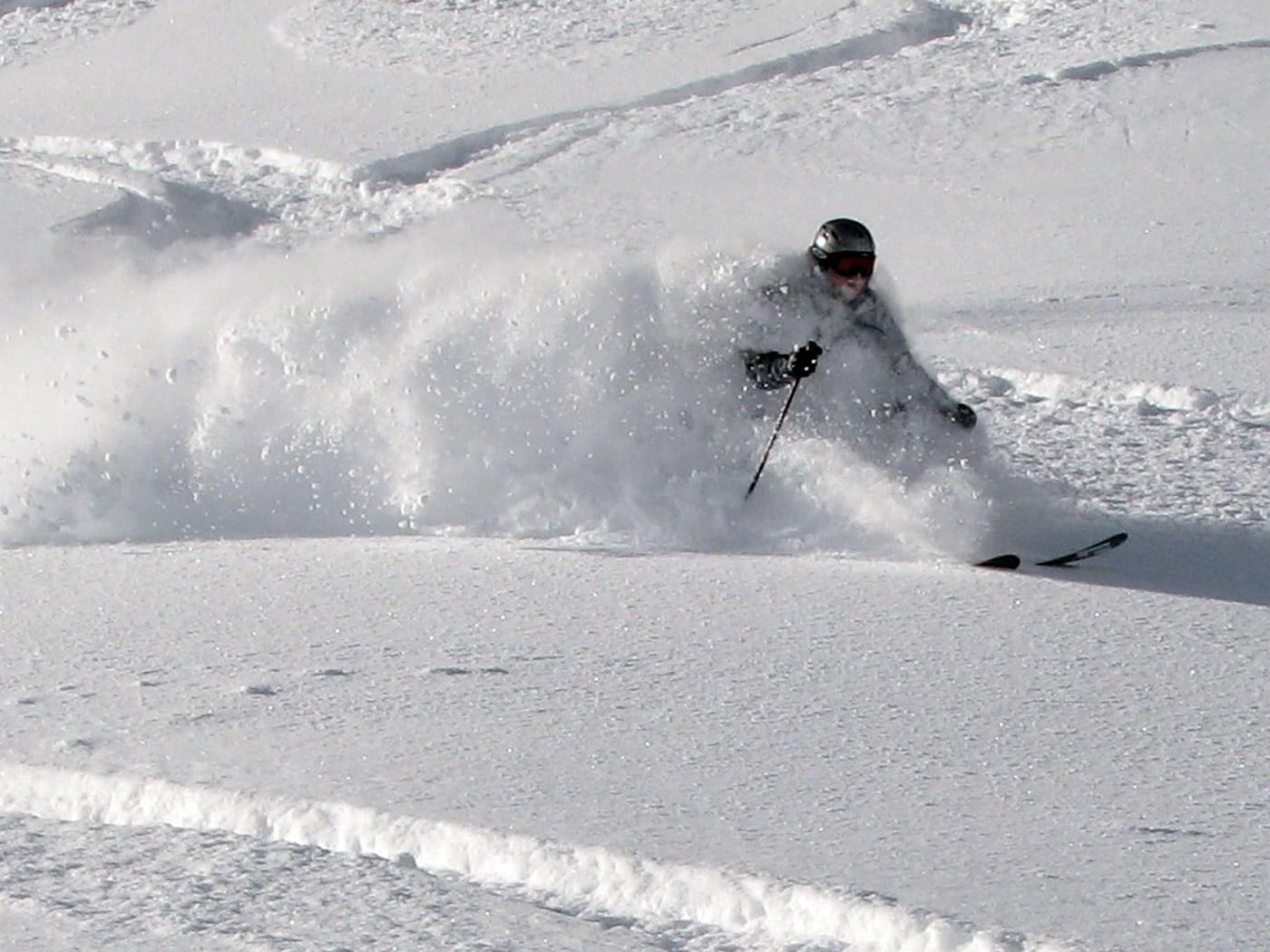
A powder day at Alta in February, 2011. Photo provided by Denis Bogan.
Slopes were incredibly steep for a brain calibrated to Mid-Atlantic skiing. Descents that looked death-defying were actually very skiable because the snow was so good. It took a few days to push back fear and adapt to a new normal. The first time we pulled into the parking lot we had a straight-on view of High Rustler, Alta’s signature run. I thought it was an just an avalanche chute, too steep to be a ski run. By the end of the week I had skied it, as well as Devil’s Castle, and other places for which I have no names. Wow!
I started ending each season with a western trip, soon adding Taos, Whistler Blackcomb, Squaw, Jackson Hole, Big Sky, Mammoth, Fernie, Red Mountain, Whitewater, Banff Lake Louise. It goes on. These trips were typically with one of my kids. I have a lifetime habit of bringing powder dumps on first trips anywhere. A friend says I have a magic door that opens onto vast powder fields. On my first Mammoth trip it snowed all week, 9 feet in 6 days. The higher lifts never opened due to wind. Sometimes lightning shut down all of them.
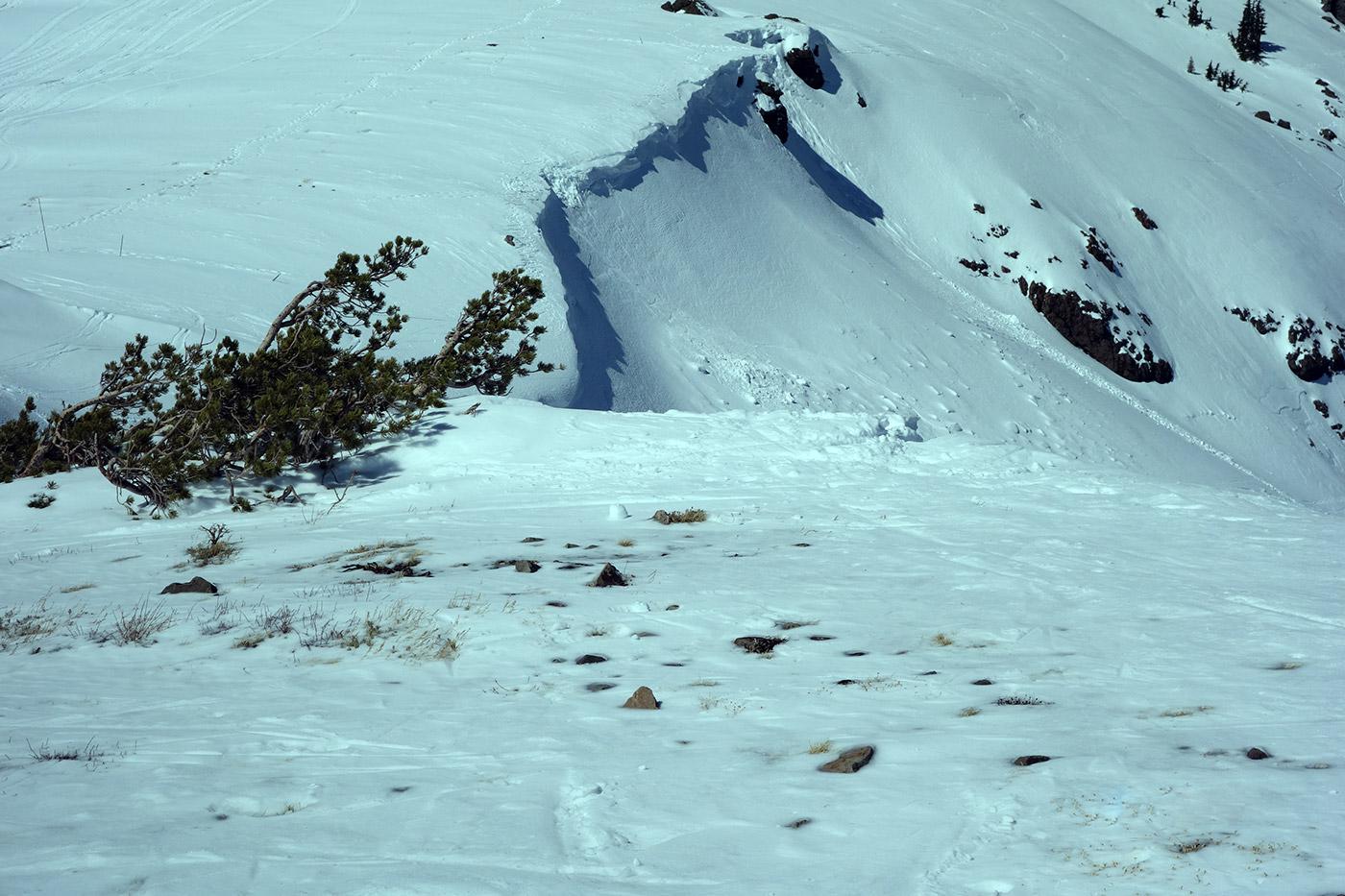
Squaw Valley in March, 2014. Photo provided by Denis Bogan.
Scott: What was the most unusual ski vacation that you’ve had?
Denis: My son and I skied in Denali National park in 2010. We arranged the trip ourselves when a trip we wanted to book canceled due to insufficient interest. We were flown in on a ski plane to the Ruth Ampitheater, a vast glacier in the midst of the Alaska range, and dropped off for 3-5 days, just the two of us plus our guide.
When the plane left we were on our own; weather is a constant unknown and the trip might have been called short at any time. Or, we might have had to hunker down and wait out a multi-day storm. We had 10 days of food and fuel for that contingency. We climbed and skied a “minor” 11,000-foot peak a few miles from Denali, toured the glacier, harnessed and roped up, carrying ice axes and wearing crampons. It is heavily crevassed. We were drilled and tested on some basic glacier travel skills back in Talkeetna before we were permitted on this phase of the trip.
We camped in a tent on 5,600 feet of glacial ice and experienced one -15 degree night. It was awesome and awesomely intimidating. Weather began to close in and we were rescued on day 4 just ahead of an oncoming storm.
Scott: If I recall correctly, you were once a PSIA ski instructor, right? When did you begin instructing, and what was that experience like?
Denis: A friend belonged to a group called Teen Winter Sports and convinced me to join. We took teens on bus trips to ski, mostly day trips in the Mid-Atlantic but also weekends at places like Hunter Mountain, Killington and Whiteface. We were all asked to become PSIA instructors if we could, but were also chaperones. I took and passed the Level 1 instructor test in 1993, and Level 2 soon after.
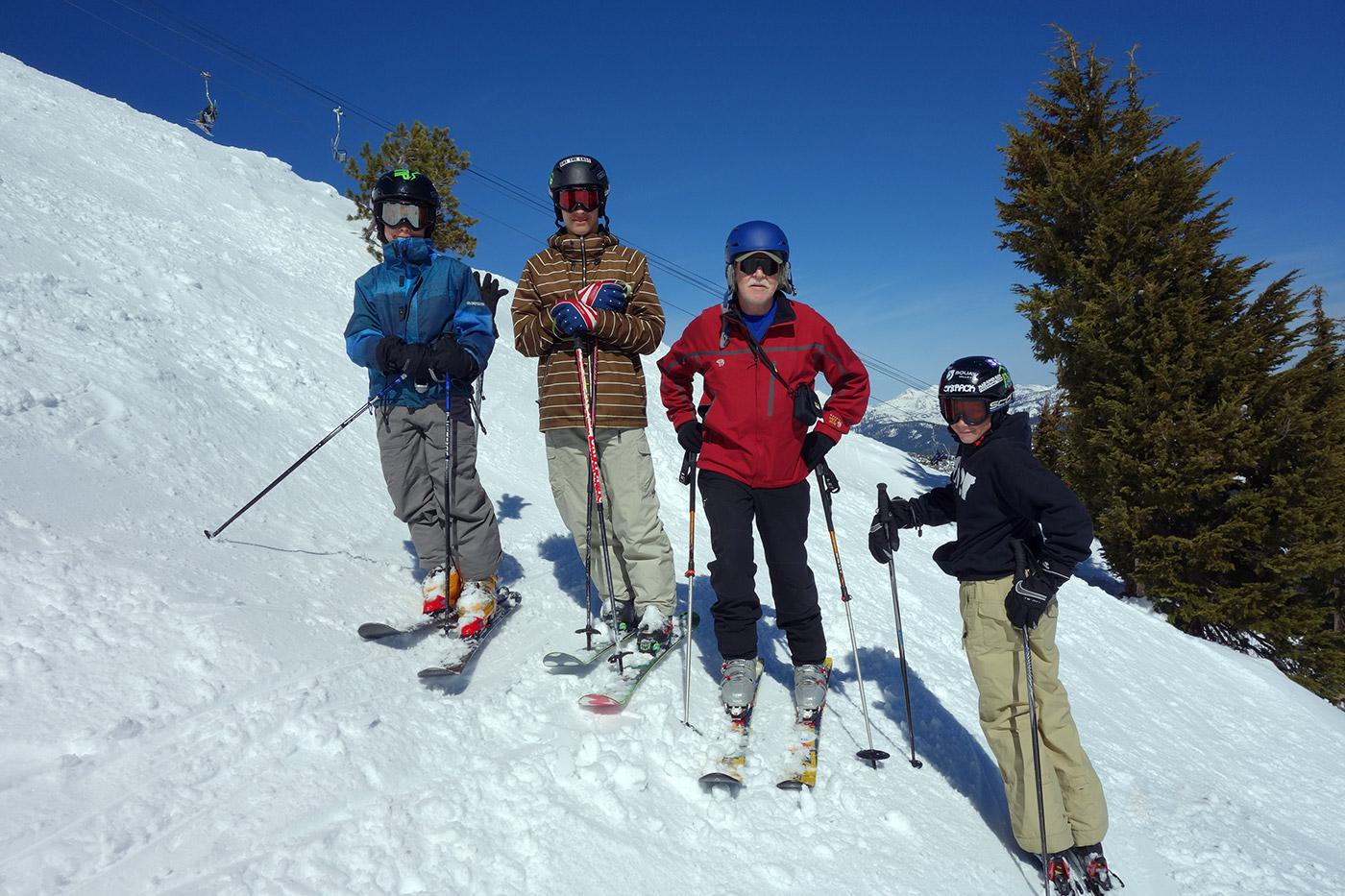
Denis hits the slopes of Squaw Valley in 2014 with his grandsons. Photo provided by Denis Bogan.
The students on these trips rarely asked for instruction — how embarrassing is that in front of your friends? — so we got to free ski a lot. Our trainer, my mentor in the group, retired and moved west and I became the trainer of our instructors. I would take the very reasonably priced PSIA instructor clinics in December every year. That, plus the earlier racing, is how I became a good skier.
I decided to try for PSIA telemark as well and attained Level 2 certification. Also level 1 cross country, track and skate. Many of the old TWS staff are now in TASC, Teen Adventures Skiing and Camping. They also do Canadian wilderness fishing trips in summer.
Scott: If someone was considering becoming a ski instructor today, what advice would you give them?
Denis: Do it because you love it and would like to pass your love of the sport to others. There is little money in it; most of what you pay for a ski lesson at a resort goes to the mountain, not the instructor. It is readily doable as a part timer, but you will have to commit to a certain amount of weekend days and maybe nights. After moving to California I wanted to try a full time experience at a mountain ski school, so I taught one season at Sierra at Tahoe.
Scott: I know you’re retired now. What did you do before you retired?
Denis: I had the enormous good fortune to spend a career in science in three distinct career phases.
I enjoy, actually need, a change of scene and a new challenge from time to time. I left the Naval Research Laboratory and became a chemistry professor at Catholic University of America. Next came a one year senior fellowship at NASA’s Goddard Space Flight Center, then an opportunity to go to NASA Headquarters and work as a mission program scientist. Every mission has a program scientist and a program executive at headquarters. These positions are not hands-on but they are essential to mission development and to meeting the agreed-upon science objectives.
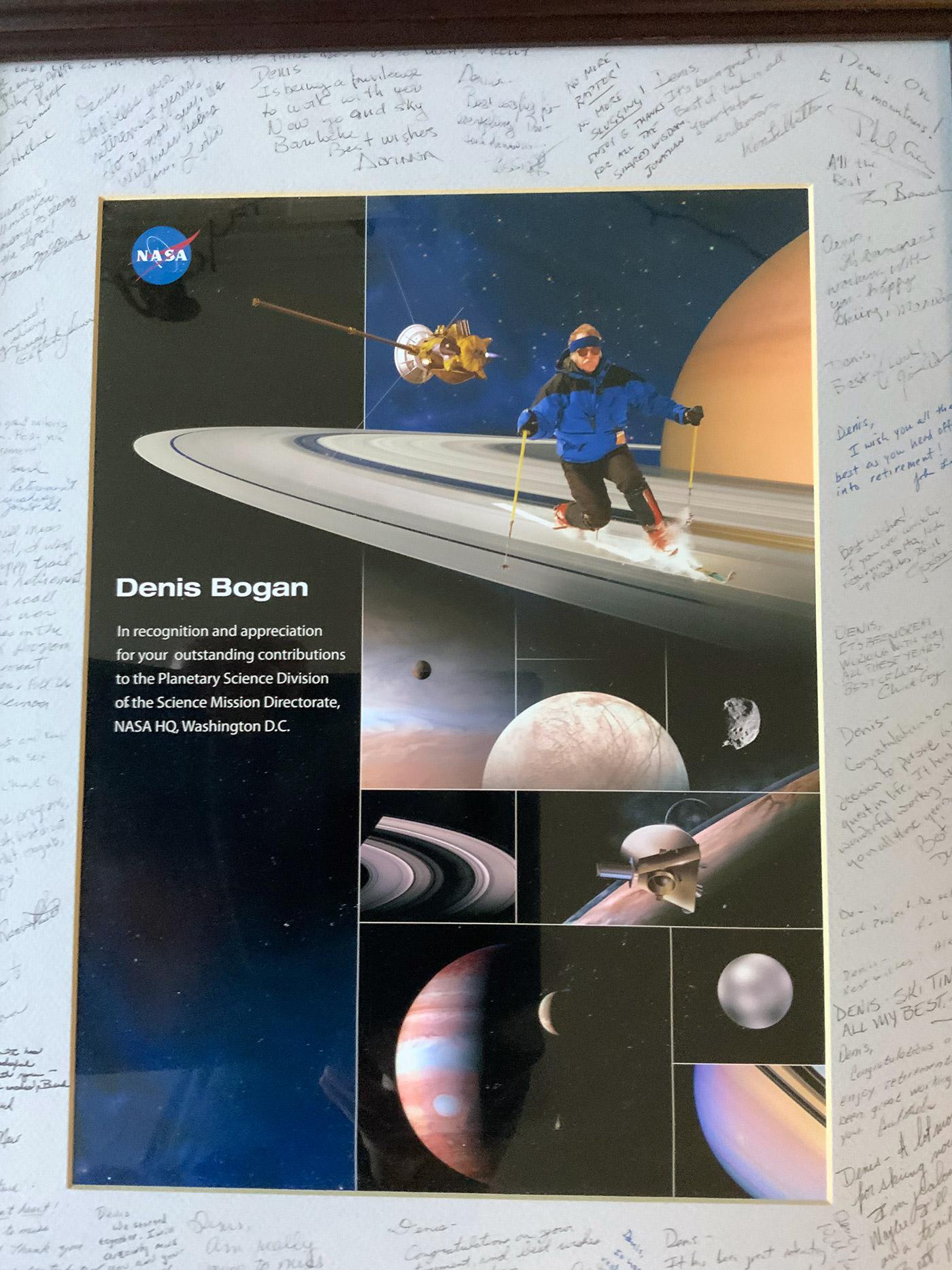
NASA retirement picture. Photo provided by Denis Bogan.
Scott: You eventually moved to California. What have you enjoyed most about living there? Is there anything you miss about the Mid-Atlantic?
Denis: My wife and I are different in what we like to do. She doesn’t ski and loves the energy of cities, having spent part of her growing up years in New York City. I love the outdoors and the mountains, preferably big mountains where it snows in feet, not inches. She wanted to retire in New York, I didn’t. Both of us have always liked San Francisco. When our daughter and family moved here the decision was made.
Scott: Earlier this year, you shared on DCSki that you had a total hip replacement. How is your recovery coming along? How has COVID-19 impacted things?
Denis: Progress has been slow. I wish it were going faster but overall I can’t complain and given COVID, what better season for rest and recovery?
Scott: Skiing is a lifetime sport, but it can become more challenging as we age. What advice would you give skiers as they age?
Denis: Listen to you body, take naps, give yourself permission to pass on doing things you once did. But — on powder days go for it, skip lunch and ski until you are about to drop, then take a late lunch.
Scott: One of the big stories of 2020 has been the COVID-19 pandemic, of course, and it’s had an impact on virtually every industry, including the ski industry. Once COVID-19 is behind us, do you have ski goals for upcoming seasons? Is there a resort you’ve always wanted to visit but haven’t been able to?
Denis: The window has probably passed. I’ll soon be 80. I’ve heard wondrous things about Japan powder but my physical capacity isn’t up to it any more. It would be very expensive and I’d have to spend as much or more time resting than skiing. Everyone talks about Europe but I think it’s as much about the apres as the skiing. Besides, I’ve been to Montana, British Columbia and Alaska.
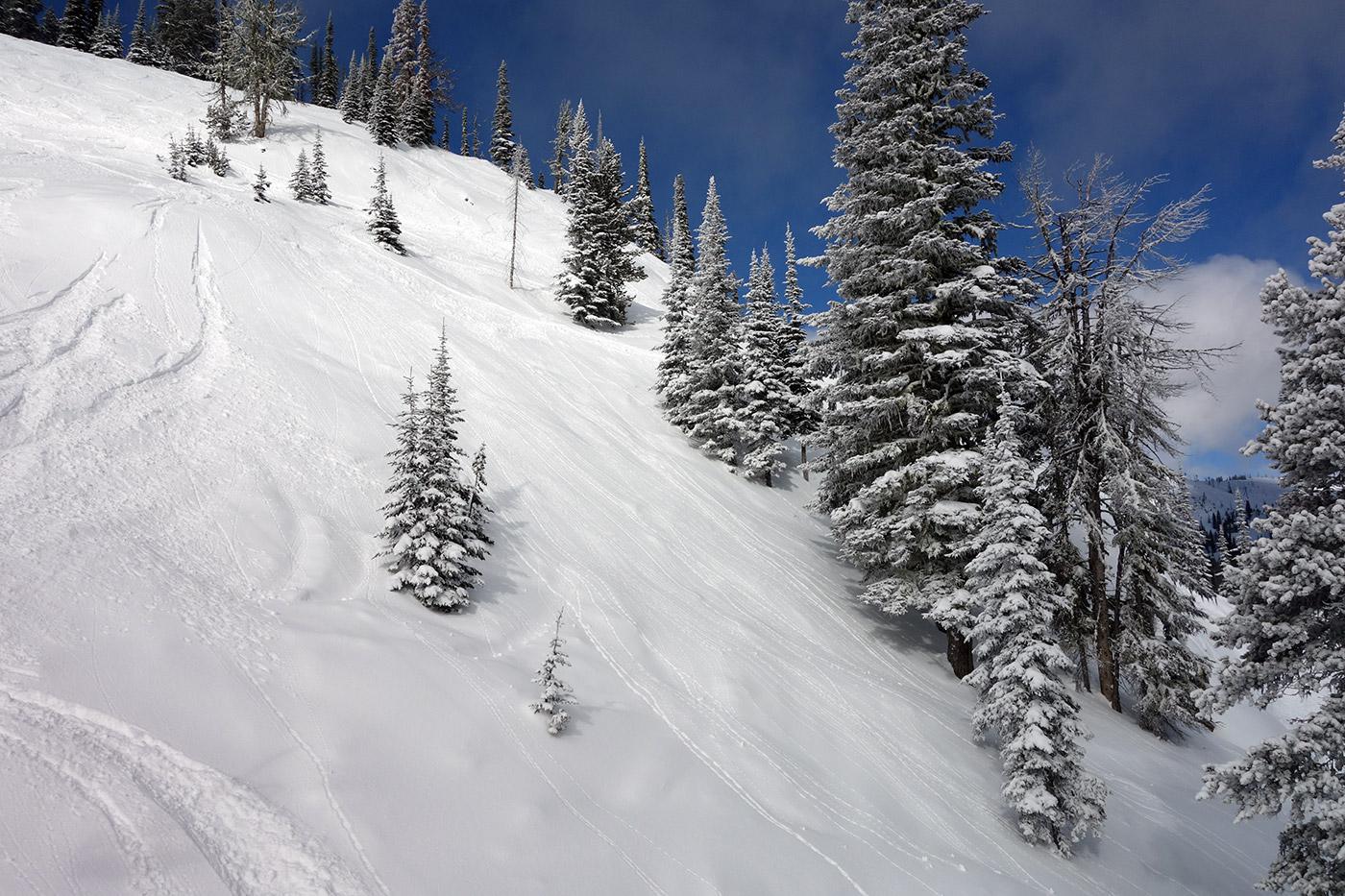
Lost Trail Ski Area in Montana. Photo provided by Denis Bogan.
Scott: Outside of skiing, what are some of your favorite activities?
Denis: Fly fishing. I was really into it in high school. I tied my own flies and rode my bike 20 miles roundtrip to a good trout stream. It was inexpensive and I had no money. While living in Virginia I took many hikes into Shenandoah National Park to fish for wild brook trout. I used barbless hooks and released them. Wild trout are too precious a resource to deplete. Since getting more into skiing I’ve neglected to do enough fishing. That needs to change.
Scott: You’ve been a member of the DCSki community for a long time — approaching two decades — and I imagine you’ve made a few friends through the site along the way. What are some of the connections that DCSki has enabled for you?
Denis: I’ve made many friends, skied with quite a few, and gotten to know many more through our posts back and forth. If I named names I’d forget somebody.
Scott: What is something about you that your fellow DCSki’ers don’t know, or would be surprised to learn?
Denis: I’m seriously afraid of heights, really the exposure more than the height. This is very familiar to climbers. If I am on the highest point in the neighborhood I’m scared. If there is a rock or a small tree beside me that goes a little higher than my head that’s much better. Friends tell me that I’ve skied steeper stuff in the trees than on exposed ridge lines.
Scott: As you think back to your experiences skiing, do any other thoughts come to mind?
Denis: The West is great but there is still a special place in my heart for northern New England.
In the 90’s my daughter and family moved to Burlington, Vermont, and skiing there with them soon followed. The family mountain was Mad River Glen. I bought a share of the coop. This, plus joining the SkiVT-List, an Internet forum much like DCSki, allowed me to make many ski friends, most super skiers, who were an inspiration as well as generous in revealing the secret runs of the woods.
My daughter became an instructor at Mad River and coached the 8-12 year olds on the Free Ski Team. All 3 grandsons learned their skills there. They were there for 15 years before moving to California. This led to my wife and I moving to San Francisco for retirement. I am a little older and retired first, at age 67. I was in good health and in retrospect it was the right time. We were still in Virginia. In the first few years I’d get two passes, Mad River, or Stowe for the East, and Alta for the West, and take two 3-4 week ski road trips, with a return home for a while in between. I drove All Wheel Drive Subarus with good snow tires.
Since the move to California in 2014 it has been almost exclusively west coast skiing, Tahoe areas, Mammoth, and Mt. Hood, Oregon. With age, I began mellowing out, skiing just 2-3 hours per day, needing a full day’s rest every third day. I’m losing the mindset for doing the toughest runs. Why should I? I’ve been there, done that.
Scott: Thanks, Denis, for taking the time to reflect on your skiing adventures and sharing it with us.
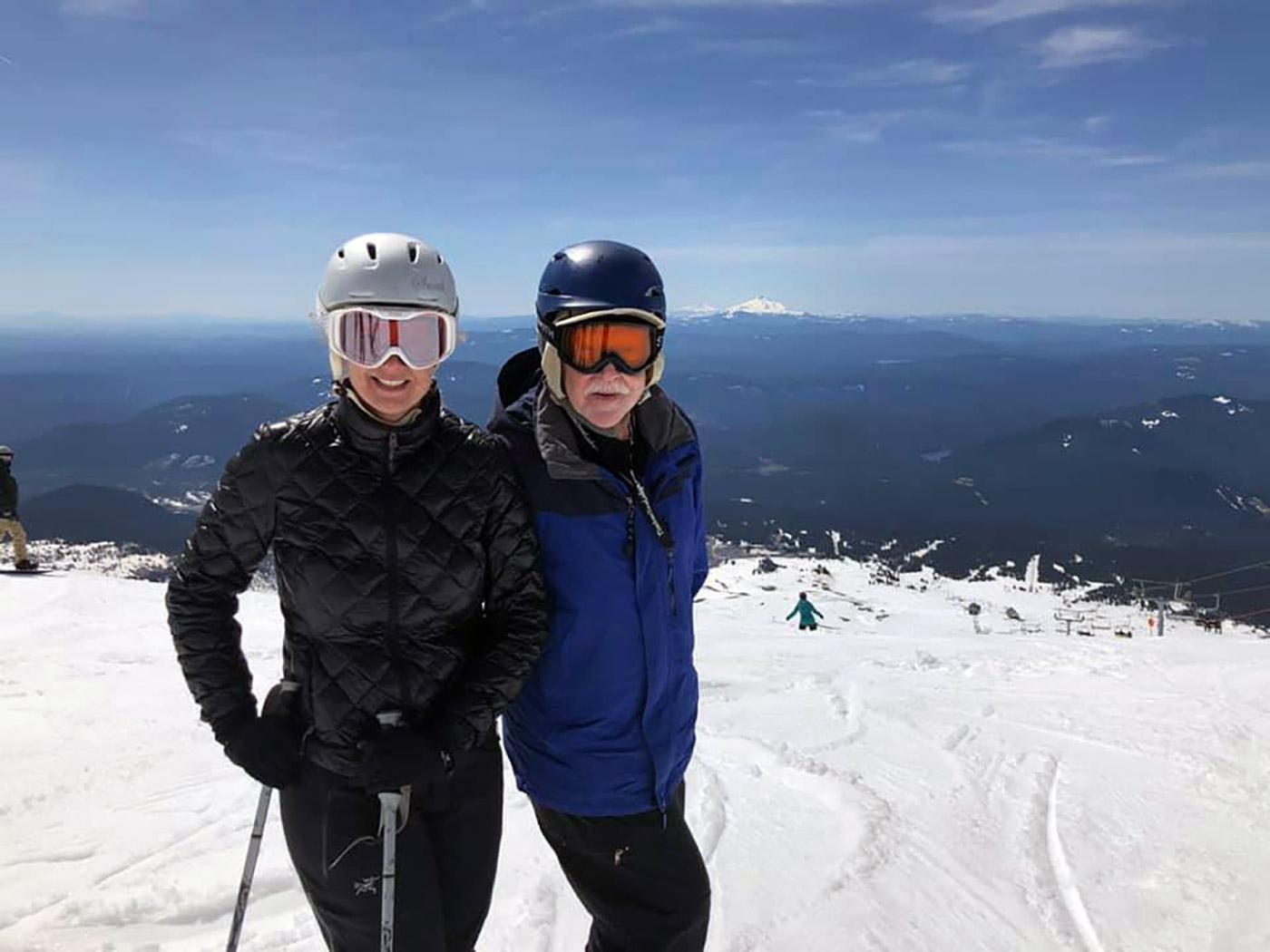
Denis skis with his daughter at Mt. Hood, Oregon in May, 2019. Photo provided by Denis Bogan.
There are no reader comments on this article yet.
Credit: Source link






























